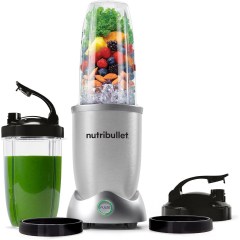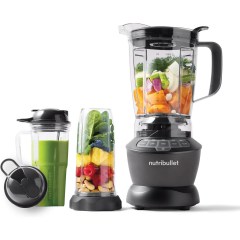Buying guide for best NutriBullet blenders
Is there anyone who doesn’t like smoothies? Whether your taste leans toward fruity and sweet or green and good for you, you can’t argue with the health benefits of adding more fresh fruits and veggies to your daily menu. One of the simplest ways to do so is by whipping up a nutrition-packed smoothie in a NutriBullet blender.
A NutriBullet blender’s powerful motor can blast through pulp, skin, seeds, and stems that would stymie other blenders. You can make healthful smoothies with fresh produce in just seconds with these handy gadgets. And there’s no pulpy mess to clean up afterward. But there are lots of different NutriBullet models, so how do you choose the right one for you?
If you’re thinking about buying a NutriBullet blender, this shopping guide has plenty of information to savor.
What is a NutriBullet blender?
The NutriBullet blender debuted in 2012. It’s a descendent of the Magic Bullet, a small, personal blender with a distinctive upside-down configuration that was released about a decade earlier. With a more powerful motor and larger cups, the NutriBullet has gone on to sell millions of units and gain many devoted users. NutriBullet models with added capabilities—from heat to Bluetooth connectivity—later joined the lineup.
When first introduced, NutriBullet blenders were targeted at an older audience interested in “slowing down the aging process.” Today, the benefits of eating more fresh fruits and vegetables are legion, and NutriBullet blenders appeal to anyone who wants to eat a healthier diet.
Dietary guidelines published by the USDA recommend that we focus on eating whole fruits, a varied assortment of vegetables of all colors, low-fat dairy, and less sugar and fat. The guidelines also encourage us to fill half our plates with fruits and vegetables—although there’s nothing that says that a half-plate full of spinach, almonds, and bananas can’t be in liquid form.
If you’re looking for a well-designed, powerful blender that’s easy to use, easy to clean, and reasonably priced, a NutriBullet is hard to beat. And if you eat more fruits and vegetables along the way, that’s a good thing, too.
The pitcher and blending cups of most NutriBullet blenders are dishwasher safe for easy cleanup.
STAFF
BestReviews
NutriBullet blenders vs. other countertop blenders
The NutriBullet is not advertised as a blender so much as a “nutrient extractor,” promising to “virtually predigest” food to make it easier for the body to absorb the nutrients. Traditional countertop blenders also pulverize and liquefy foods, so what’s the difference between those and NutriBullet blenders? Each type has some distinctive features.
NutriBullet blenders
- Powerful wattage with 600-watt to 1,700-watt motors
- One speed (most models)
- One design (upside-down cup)
- One use (liquefy produce)
- One temperature (most models)
- Powerful (processes seeds, nuts, stems, pulp, and skin that can jam other blenders)
- Fast (10 seconds or less)
- Convenient (single blending/drinking cup)
- Easy to clean
- Great for single-serve portions and small batches
- Less expensive than similarly powered blenders
Other countertop blenders
- 300-watt to 1,500-watt motors (household models average 450 watts)
- Three to 10 speeds
- Many designs
- Many uses
- Hot or cold foods
- Glass, polycarbonate, or stainless steel containers
- Larger containers
- Tamper to push stuck food toward the blades
- Extras (touchpads, programmable controls)
- Longer warranty
DID YOU KNOW?
Over 85% of the nutrients in many fruits and vegetables can be found in the pulp, peel, and seeds—parts that juicers remove and blenders often can’t handle. Add cantaloupe seeds, lemon seeds and pith, or pineapple cores to your smoothies with a NutriBullet blender, and reap the nutritional benefits of these superfoods.
STAFF
BestReviews
Types of NutriBullet blenders
All the NutriBullet models come with at least two cups, a single-serve cup, two removable lip rings, two lids, a user manual, and a recipe book. Some NutriBullet blender combos include spacious blending pitchers in addition to smaller cups for personalized portions.
The original NutriBullet comes in three colors, has a 600-watt motor, one speed, an extractor blade, and a 24-ounce capacity.
The NutriBullet Pro has a 900-watt motor, one speed, an extractor blade, a to-go lid, and a 32-ounce capacity.
The NutriBullet Select has a 950-watt motor, an extractor blade, three pre-programmed settings, five variable speeds, and a 32-ounce capacity.
The NutriBullet Balance has a 1,200-watt motor, one speed (but the included app can vary speed and duration), a precision extractor blade, a Bluetooth-enabled Smart Nutrition Sensor, an app, an integrated scale, and a 32-ounce capacity.
The NutriBullet Rx has a high-speed 1,700-watt motor, a seven-minute heating cycle, an extractor blade, hands-free Smart Technology with auto on/off, a SouperBlast pitcher with a vented lid, and a 45-ounce capacity.
The NutriBullet Baby Bullet is for preparing baby food and has a 200-watt motor, a blending blade, a milling blade, and six date-dial storage cups.
The Dessert Bullet is for preparing desserts from frozen ingredients and has a 350-watt motor, a feed tube and barrel, a pusher, and a spout.
DID YOU KNOW?
Some NutriBullet blenders come with single-serve cups with flip-top lids for enjoying tasty concoctions on the go.
STAFF
BestReviews
NutriBullet blender prices
Inexpensive
The Magic Bullet Mini, NutriBullet Go, and Original Magic bullet all cost under $60. These lightweight, compact blenders are designed primarily for travel. If you want something lightweight for on the go, look here.
Mid-range
Several great NutriBullet options cost greater than $60 but not much more than $100. For example, you can buy a 900-watt NutriBullet blender complete with two cups, two lip rings, and two lids for less than $100. Replacement parts, such as a 24-ounce cup ($12) or extractor blade ($20), can be found on the company’s website.
High-end
The priciest NutriBullet options sit between $120 and $190. These appliances tend to have more power and more features. If you’re looking for a countertop appliance and want to pamper yourself with the best the brand has to offer, look in this price range.
NutriBullet blenders are designed to do one thing very well—blend—so they don’t have all the features, or the price tag, of top-of-the-line countertop blenders. Whether you buy the original, no-frills 600-watt NutriBullet or a 1,700-watt NutriBullet Rx, you’ll spend approximately $60 to $190, which is considerably less than you’d pay for a comparably powered countertop blender.
STAFF
BestReviews
Tips
- Get creative. Use your NutriBullet blender to purée the bits you might otherwise toss out, such as tough asparagus stems or washed carrot skins, and use the purée to make hot soups.
- Stock up in season. When fruits and vegetables are at the peak of freshness, stock up at the farmers’ market, pulverize the produce, and freeze it in muffin pans. The “muffins” can then be stored in resealable plastic bags. When you’re ready to make a smoothie, just add one of your frozen kale or strawberry cubes to the other ingredients in the NutriBullet blender.
- Surprise a picky eater. Think your child won’t touch cauliflower? Broccoli? Chia seeds? You can use your NutriBullet blender to whip up a kid-friendly smoothie full of nutritious vegetables as well as the apples, grapes, and bananas they already love.
- Know the good from the bad. While there are many seeds you can add to your smoothies, you should never add the seeds or pits from apples, pears, apricots, peaches, nectarines, plums, or cherries. These contain amygdalin, a bitter compound that produces cyanide when pulverized.
- Vary your vitamins. Broccoli, pistachio seeds, and avocado provide vitamin B6. Strawberries, kale, and papaya are full of vitamin C. Swiss chard, beans, and coconut water are loaded with potassium. For a creamier smoothie, try adding cottage cheese or cooked chunks of sweet potato. For sweetness and thickening, try figs, pitted dates, or beets.
- Enjoy experimenting. Use your NutriBullet to make soups, protein shakes, nut butters, milkshakes, and more.
FAQ
Q. How do I prepare different fruits and vegetables for my NutriBullet blender?
A. Many foods, such as blueberries or cucumbers, only require a rinse before tossing them in. For others, such as cantaloupe, you must remove the rind. For stone fruits or avocados, you must remove the pit.
Q. Can I add unpeeled bananas?
A. The skins of many fruits are packed with nutrition. For example, apple and apricot skins are high in vitamin C. While you probably never eat the skin on a banana, it is edible and high in fiber, and you can add it to your smoothies. However, be sure to only eat organic banana peels. Pesticides and other chemicals are used for growing non-organic bananas and can collect in the peels.
Q. My NutriBullet blender leaks sometimes. Is it broken?
A. Leaks can happen for a couple reasons: putting too much liquid in the container or a loose connection between the container and base. Pay attention to the maximum fill line so you don’t overfill the container. And make sure you securely screw the container onto the base before turning on your NutriBullet blender.



























